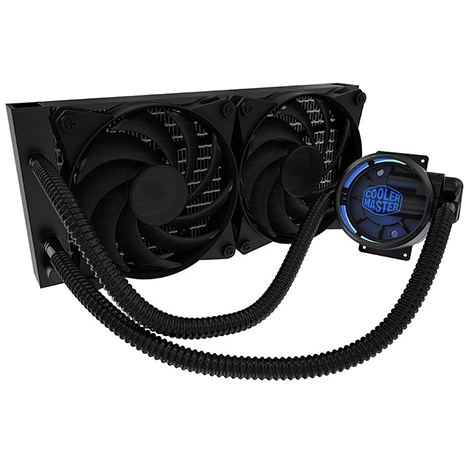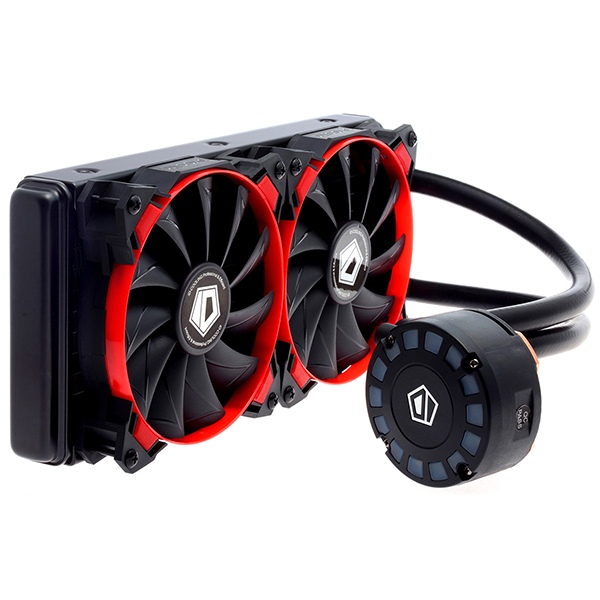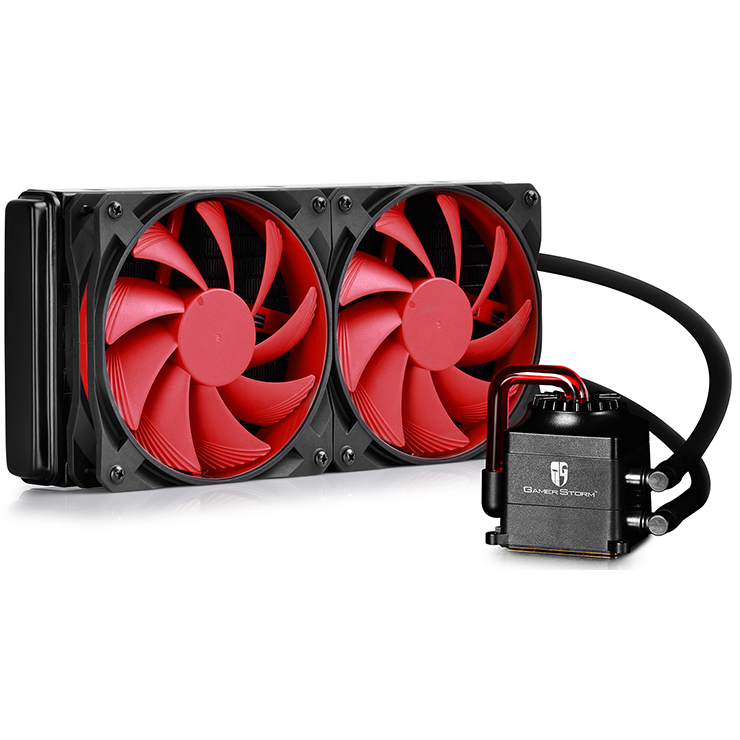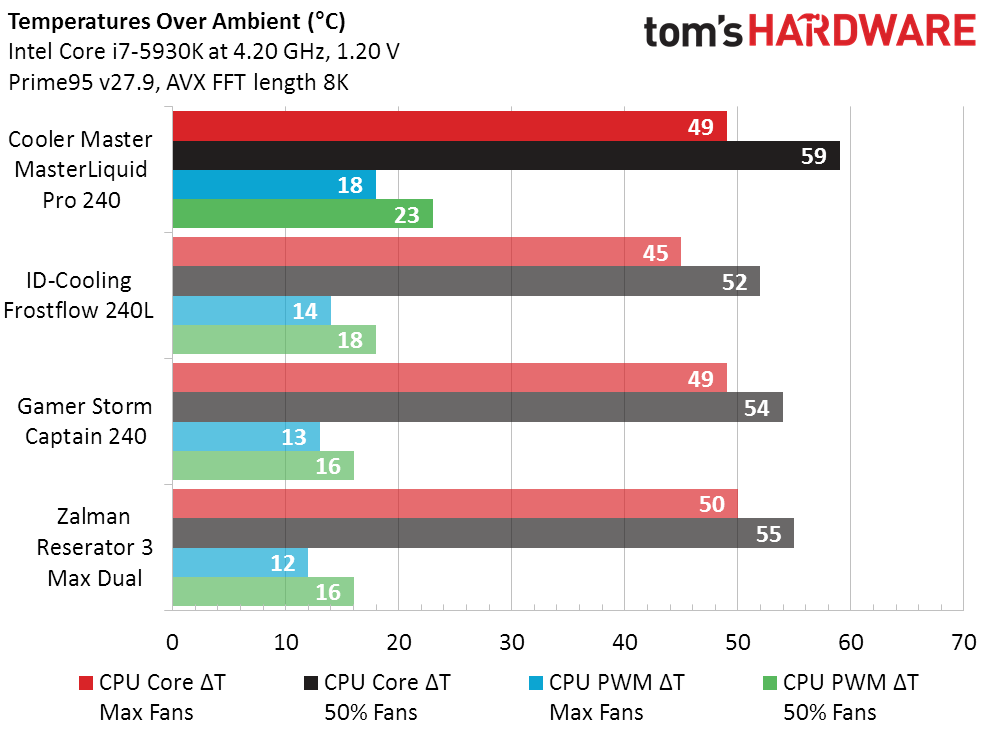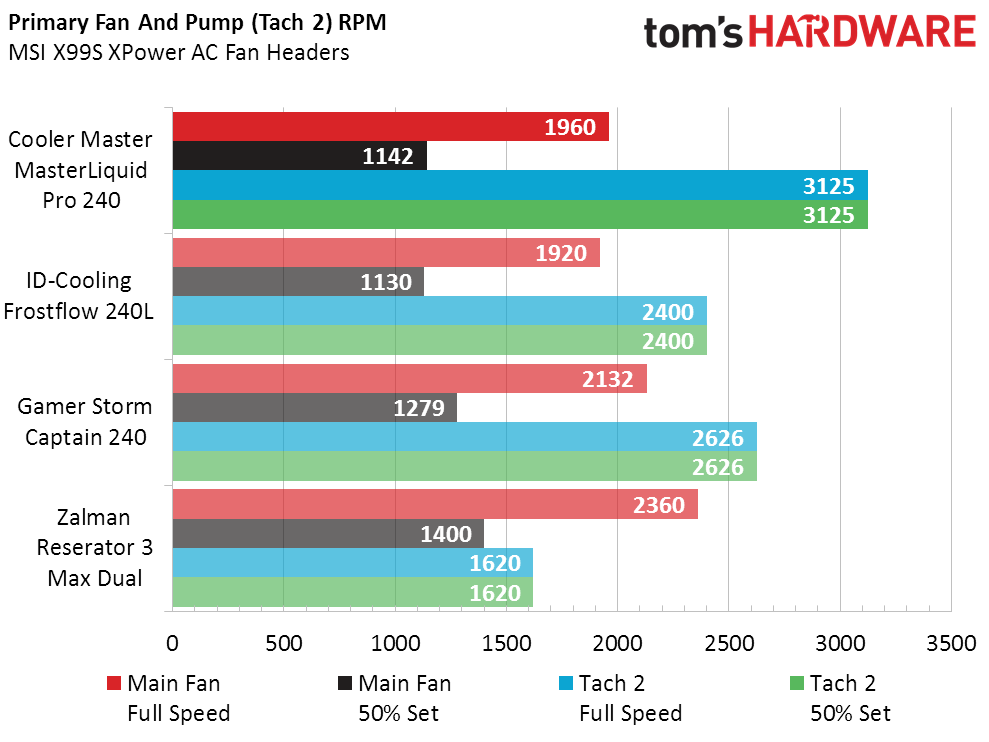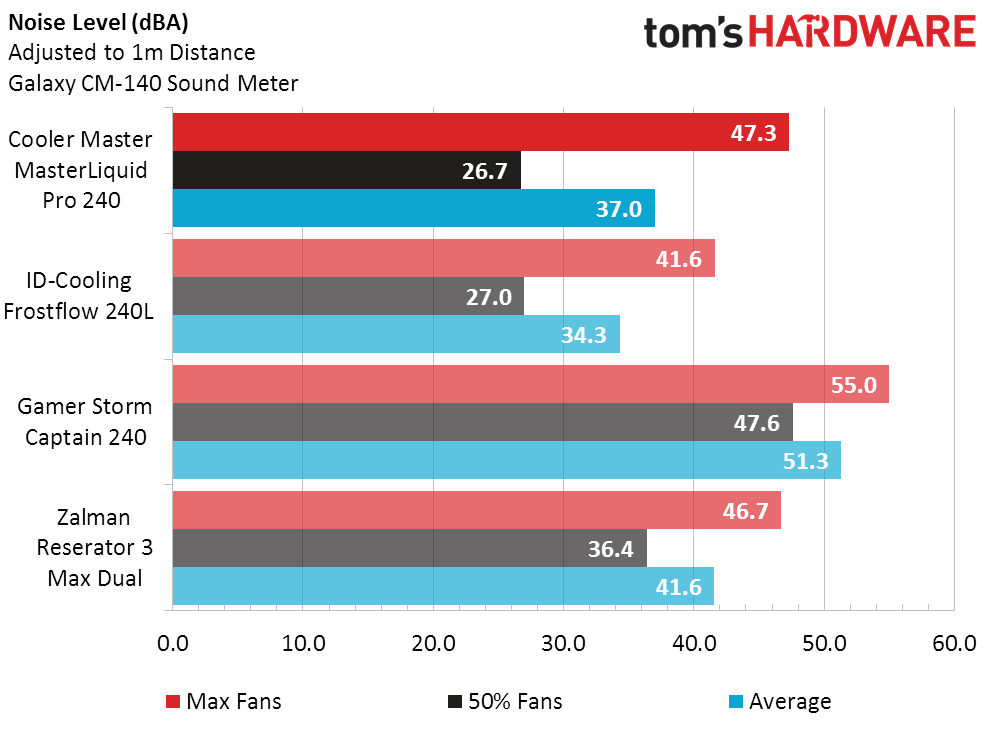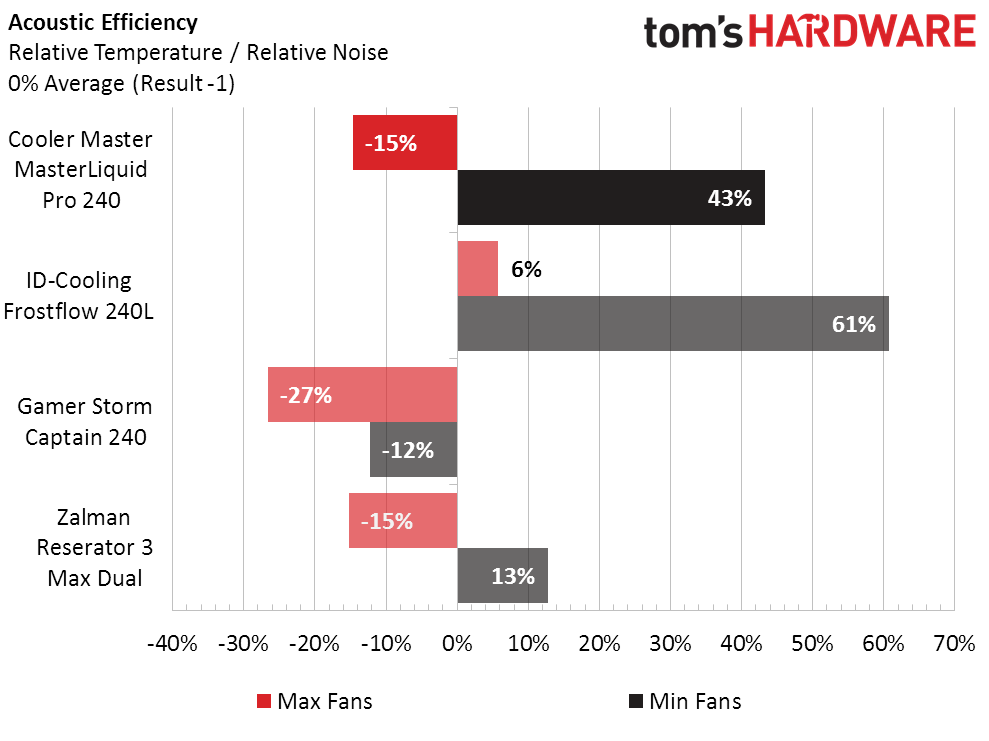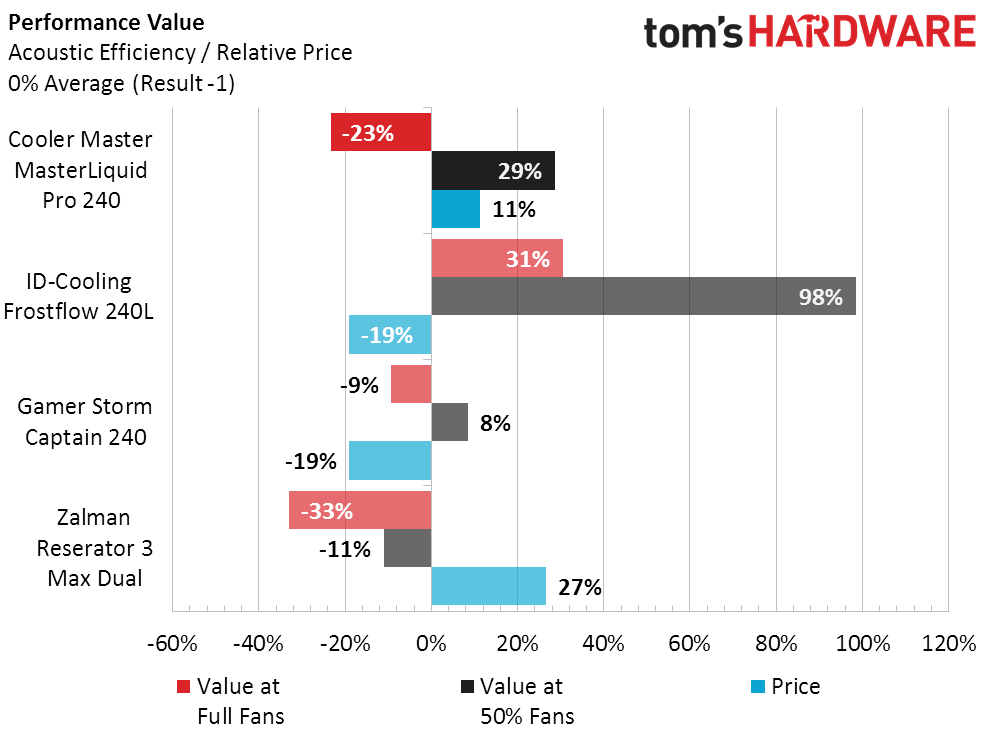Cooler Master MasterLiquid Pro 240 CPU Cooler Review
Cooler Master believes its MasterLiquid Pro 240 can overcome competitors in the 2x 120mm closed-loop cooler space with better performance for the money. Are they right?
Why you can trust Tom's Hardware
Test Methods, Results And Conclusion
We retain the hardware configuration from previous big cooler reviews to maintain result consistency. Here's how it compares dimensionally to other models in today's test.
Liquid CPU Cooler Specifications
Test Results
Cooler Master’s thermal results are extra competitive at max fans, even though it falls behind at 50% fans. The PWM-based CPU Voltage Regulator gets most of its cooling from fans being placed in close proximity.
Rated at 3300 RPM max, the MasterLiquid Pro 240’s pump sent a 9375 RPM signal to our motherboard. Cooler Master wasn’t able to confirm the number of pulses per revolution, so we divided by three based on its rating. We gave the Gamer Storm Captain 240 a similar adjustment, dividing its reading by two after checking its official specs (yet it still appears the Captain 240 pump we received was running out-of-spec).
Noise level favors the MasterLiquid Pro 240 over the Captain 240. The Frostflow 240L’s results are starting to look unbelievable, and we’re beginning to entertain the notion of purchasing a random sample for retest. The only way we’ll spend that cash is if you demand it.
Cooler Master could take pride in leading the Gamer Storm Captain 240 in our cooling-to-noise comparison if not for the spoiler from ID-Cooling.
Even if a retest showed ID-Cooling in a lesser light, its direct sale from China pairs with country’s insanely-low mailing cost to give it a significant pricing advantage. Unfortunately for Cooler Master, DeepCool/Gamer Storm also dropped the price of its Captain 240.
Cooler Master did a great job of designing its Master Liquid Pro for appearance and performance, going so far as to include fans that feel more substantial than those of its competitors. Unfortunately, super-high MTTF ratings are undermined by a relatively short 2-year warranty, and high value is undermined by recent price cuts of a competitor. If we were to splash out the extra cash, appearance would be a prime determining factor.
Get Tom's Hardware's best news and in-depth reviews, straight to your inbox.
MORE: Best CPU Cooling
MORE: All Cooling Content
MORE: How To Choose A CPU Cooler
MORE: In Pictures: 20 Clever Liquid-Cooled PC Setups
Follow us on Facebook, Google+, RSS, Twitter and YouTube.
- 1
- 2
Current page: Test Methods, Results And Conclusion
Prev Page Introducing The MasterLiquid Pro 240-
Onus Nice review; the numbers don't lie. As I've generally noted, it appears that there is at least one competitor with a bang/buck advantage vs. Coolermaster. There is always a better choice.Reply
-
ammaross A retest of the ID-Cooling Frostflow may not be necessary, as other sites have confirmed similar numbers. What you DO need is to try the new Captain 240 EX which has significantly better numbers (mainly noise, but has some aesthetic improvements too) than the old Captain 240.Reply -
shrapnel_indie ReplyCons
Two-year warranty (some competitors provide three)
Uhhh. I can name at least one that (when registered) provides SIX years of warranty (three without registration) on their AiO coolers. It's too bad you haven't tested any of them, although I think you did publish a press release on them. Those who have bought them seem to think well of them, others seem to criticize them for who the apparent (basic) design belongs to.
What brand and models you may ask? CryOrig's A40, A40 Ultimate, and A80 Hybrid AiO Coolers (240mm, 240mm (thicker), and 280mm respectively.) Has anyone asked for samples to test? -
Crashman Reply
So far we've only received air coolers from Cryorig and are trying to work our way towards it. We have loads of product samples.18447459 said:Cons
Two-year warranty (some competitors provide three)
Uhhh. I can name at least one that (when registered) provides SIX years of warranty (three without registration) on their AiO coolers. It's too bad you haven't tested any of them, although I think you did publish a press release on them. Those who have bought them seem to think well of them, others seem to criticize them for who the apparent (basic) design belongs to.
What brand and models you may ask? CryOrig's A40, A40 Ultimate, and A80 Hybrid AiO Coolers (240mm, 240mm (thicker), and 280mm respectively.) Has anyone asked for samples to test?
-
ah 2 years warranty simply isn't enough, SilverStone and Corsair offer 5 years warranty without boasting the 90 years MTTF. The SilverStone's thermal plate looks pretty cool, with no screws.Reply -
JackNaylorPE Radiator material, fpi ? The word "radiator" does not even appear in the review.Reply
Tubing material ? Length ? -
Crashman Reply
It's an aluminum radiator and has 14" tubes.18453617 said:Radiator material, fpi ? The word "radiator" does not even appear in the review.
Tubing material ? Length ?
